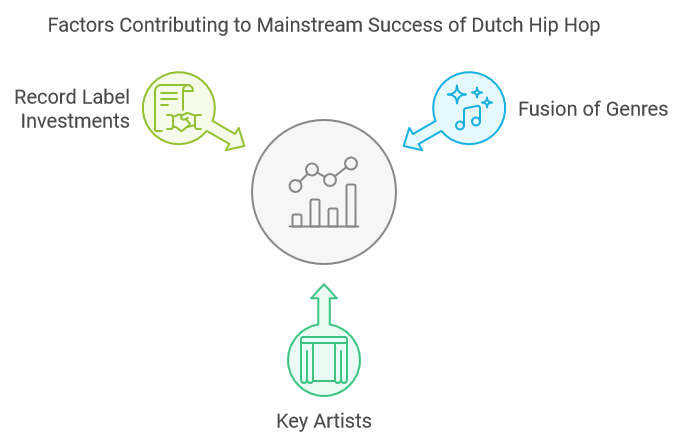Hip hop has become a vital part of Dutch culture, serving not only as a music genre but also as a platform for artistic expression, social commentary, and community building. From its roots in the urban landscapes of the Netherlands, hip hop has influenced fashion, language, and youth culture, creating a unique cultural identity that resonates with many. The genre has evolved significantly over the decades, reflecting the complexities of society and the voices of its youth.
This blog aims to explore the evolution of Dutch hip hop from its beginnings in the 1980s to its current status as a dynamic force in the music industry. We will delve into the early influences that shaped the genre, highlight key artists and their contributions, and examine the cultural impact of hip hop in the Netherlands.
1. Early Beginnings (1980s)
Dutch hip hop originated in the early 1980s, heavily influenced by American hip hop culture. As breakdancing and graffiti gained popularity in urban areas, they provided a canvas for self-expression among Dutch youth. This period marked the initial exploration of hip hop’s artistic forms, which included not just music, but also dance and visual art.
The genre began to gain traction as artists and enthusiasts embraced the vibrant energy of hip hop. While the first Dutch rap tracks emerged during this time, they were primarily performed in English, reflecting the genre’s American roots. As local artists experimented with their sound, they began to carve out a space for Dutch hip hop in the broader musical landscape.
Pioneers
Among the pioneers of Dutch hip hop were notable acts such as The 2 Brothers on the 4th Floor and MC Miker G & DJ Sven. These artists played a crucial role in bringing hip hop to mainstream Dutch audiences. Their music incorporated catchy hooks and infectious beats, helping to popularize the genre.
One of the most significant tracks from this era was “Holiday Rap,” released in 1986 by MC Miker G & DJ Sven. This hit single not only showcased the appeal of hip hop in the Netherlands but also marked a turning point in the genre’s acceptance among the wider public. Its success helped pave the way for future Dutch hip hop artists, laying the groundwork for a vibrant and diverse music scene that would continue to evolve in the years to come.
2. Formation of a Unique Identity (1990s)
Language Shift
The 1990s marked a pivotal moment for Dutch hip hop as artists began to transition from English to Dutch lyrics. This significant shift allowed for deeper connections with local audiences, fostering a unique cultural identity within the genre. Rapping in Dutch not only made the music more accessible but also enabled artists to express their thoughts, experiences, and social issues in a language familiar to their listeners. As a result, Dutch hip hop started to reflect the realities and challenges faced by youth in the Netherlands, setting it apart from its American counterparts.
This linguistic change was crucial in establishing a distinct local identity, allowing artists to carve out a space for themselves in the music industry. It enabled them to address topics relevant to Dutch society, contributing to the genre’s authenticity and resonance among listeners.
Influential Groups
One of the most influential groups in shaping Dutch hip hop during the 1990s was Osdorp Posse. Formed in 1992, this group was known for their provocative lyrics that tackled social issues such as inequality, crime, and the struggles of urban life. Their unfiltered approach challenged societal norms and sparked important conversations among youth about their realities.
Osdorp Posse’s impact was profound, as they pushed the boundaries of hip hop in the Netherlands and inspired future generations of artists. Their bold, often controversial style set a tone for the genre that embraced raw honesty and authenticity, cementing their place as pioneers in Dutch hip hop.
Local Scene
During the 1990s, the urban centers of Amsterdam and Rotterdam became the epicenters of hip hop culture in the Netherlands. These cities provided fertile ground for the growth of the genre, with vibrant communities of artists, dancers, and enthusiasts. Local clubs and venues hosted performances and battles, fostering a sense of camaraderie among aspiring musicians.
In Amsterdam, neighborhoods like the Bijlmer and the Western districts contributed to a diverse hip hop scene, while Rotterdam emerged as a hub for creative expression and experimentation. The interaction between various cultural influences in these cities helped shape the sound and style of Dutch hip hop, creating a rich tapestry of artistic expression that reflected the complexity of urban life.

3. Commercialization and Diversity (2000s)
Mainstream Success
The early 2000s marked a significant shift in the commercialization of Dutch hip hop, as artists began to achieve mainstream success. Notable figures such as Ali B, Brainpower, and The Opposites played crucial roles in popularizing the genre, blending hip hop with elements of pop and R&B. This fusion made their music appealing to a broader audience, allowing hip hop to break into the mainstream charts and gain widespread recognition.
The commercialization of Dutch hip hop also saw an increase in production quality and marketing efforts. As record labels recognized the genre’s potential, they invested in artists, leading to more polished sounds and higher visibility in the music industry.
Subgenres and Styles
During this period, Dutch hip hop diversified into various subgenres, including gangsta rap, trap music, and dance-infused styles. Artists began to experiment with different sounds, incorporating electronic elements and influences from other genres. This diversification reflected changing musical tastes, both locally and globally, as artists sought to push the boundaries of hip hop.
The influence of American hip hop remained strong, but Dutch artists started to develop their own unique styles, drawing from local culture and experiences. This blend of influences contributed to a vibrant and dynamic hip hop scene, appealing to a wide range of listeners.
Media Presence
The rise of music television channels and radio stations in the 2000s played a pivotal role in promoting Dutch hip hop. Shows dedicated to urban music and culture provided a platform for artists to showcase their work and connect with fans. This increased visibility helped to solidify hip hop’s place in the Dutch music landscape, attracting new audiences and fostering a sense of community.
As hip hop gained traction on media platforms, it became a vehicle for self-expression and storytelling, allowing artists to reach wider audiences and further establish their identities within the genre. The synergy between media presence and musical innovation contributed to the ongoing evolution of Dutch hip hop, setting the stage for its future growth and influence.

4. Contemporary Scene (2010s – Present)
New Wave of Artists
The 2010s ushered in a new wave of Dutch hip hop artists who brought fresh perspectives and sounds to the genre. Artists such as Lil’ Kleine, Ronnie Flex, and Jonna Fraser have emerged as prominent figures, each contributing to the evolution of Dutch hip hop in their unique ways.
Lil’ Kleine, known for his catchy hooks and relatable lyrics, quickly gained popularity with hits like “Drank & Drugs,” which showcased his ability to blend hip hop with contemporary pop influences. Ronnie Flex also made waves with his fusion of hip hop and dancehall, earning recognition for his engaging melodies and collaborative spirit. Jonna Fraser, with his smooth vocal style, has carved a niche within the genre, further diversifying the sound of Dutch hip hop.
Together, these artists have revitalized the genre, appealing to younger audiences and establishing hip hop as a dominant force in the Dutch music scene.
International Collaborations
The contemporary era of Dutch hip hop has seen a notable increase in international collaborations, allowing artists to broaden their reach and engage in cultural exchange. Collaborations with international musicians have introduced Dutch hip hop to global audiences, fostering a blend of styles and influences.
For instance, artists like Lil’ Kleine have worked with international stars, bringing Dutch sounds to the forefront of global music charts. These collaborations not only enhance the visibility of Dutch hip hop but also facilitate a dialogue between different musical traditions, enriching the genre as a whole.
Social Commentary
Contemporary Dutch hip hop artists often use their platforms to address pressing social issues, such as identity, inequality, and personal struggles. Their lyrics reflect the realities faced by many young people in the Netherlands, tackling themes of mental health, cultural identity, and societal pressures.
For example, artists like Ronnie Flex and Jonna Fraser incorporate personal narratives and social commentary into their music, resonating deeply with listeners. This focus on authenticity and relevance contributes to meaningful dialogue within society, positioning Dutch hip hop as a powerful medium for self-expression and social critique.
5. Cultural Impact
Influence on Dutch Society
Dutch hip hop has significantly influenced youth culture, shaping trends in fashion, language, and social behavior. The genre has become a form of self-expression for many young people, providing a voice for their experiences and aspirations.
Fashion inspired by hip hop culture, including streetwear brands and styles, has permeated mainstream culture, with young people adopting these trends as a way to express their identity. Moreover, the language of hip hop has influenced everyday speech, introducing new slang and expressions that resonate with the youth.
Digital Age and Streaming
The rise of social media and streaming platforms has transformed the landscape of music distribution and fan engagement. Platforms like Spotify, YouTube, and Instagram have made it easier for artists to share their music and connect with fans, leading to the rapid dissemination of Dutch hip hop.
These platforms allow artists to cultivate a strong online presence, enabling them to interact directly with their audience and promote their work without the need for traditional media gatekeepers. The accessibility of digital tools has empowered a new generation of artists to create and share their music, further contributing to the growth and diversification of Dutch hip hop in the digital age.
Conclusion
The evolution of Dutch hip hop from its early influences in the 1980s to its current status as a significant cultural force reflects a dynamic and transformative journey. What began as a movement heavily inspired by American hip hop culture has grown into a vibrant genre that embodies the voices and experiences of Dutch youth. The transition to Dutch lyrics in the 1990s marked a turning point, allowing artists to forge a unique identity and address local social issues. As the genre commercialized in the 2000s, it diversified into various styles and subgenres, leading to a flourishing contemporary scene characterized by new artists, international collaborations, and meaningful social commentary.
Today, Dutch hip hop continues to evolve and adapt, engaging with pressing societal issues while also influencing fashion and youth culture. The genre’s ongoing growth and diversification highlight its resilience and relevance in a rapidly changing musical landscape, ensuring that it remains a powerful medium for self-expression and cultural dialogue.
Resources
Articles and Interviews
- van der Zanden, R. (2020). The Rise of Dutch Hip Hop: A Historical Overview. The Culture Trip.
- van Litsenburg, M. (2019). From the Bronx to the Dam: The Evolution of Dutch Hip Hop. Noisey.
Books
- Smits, K. (2017). Hip Hop in the Netherlands: The Cultural Dynamics of Dutch Rap. Amsterdam University Press.
- Huber, J. (2015). Rap Music and Hip Hop Culture: A Global Perspective. Routledge.
Documentaries
- The Story of Dutch Hip Hop – A documentary that explores the evolution of hip hop in the Netherlands and highlights key artists and cultural impacts.
FAQ
1. What is the origin of Dutch hip hop?
Dutch hip hop originated in the early 1980s, heavily influenced by American hip hop culture. It began with breakdancing and graffiti in urban areas, leading to the emergence of rap music in the Netherlands.
2. Who were the pioneers of Dutch hip hop?
Notable pioneers include The 2 Brothers on the 4th Floor and MC Miker G & DJ Sven, with the latter’s hit single “Holiday Rap” (1986) helping to introduce hip hop to a broader Dutch audience.
3. When did artists start rapping in Dutch?
The transition to Dutch lyrics began in the early 1990s, marking a significant turning point in the genre and helping to establish a distinct local identity.
4. What role did Osdorp Posse play in Dutch hip hop?
Osdorp Posse, formed in 1992, was one of the first groups to gain popularity by rapping in Dutch. Their provocative lyrics addressed social issues, resonating with many young people and influencing future generations of artists.
5. How did Dutch hip hop evolve in the 2000s?
The early 2000s saw the commercialization of Dutch hip hop, with artists like Ali B, Brainpower, and The Opposites achieving mainstream success. The genre also diversified into various subgenres, including gangsta rap and trap music.
6. Who are some contemporary Dutch hip hop artists?
Prominent contemporary artists include Lil’ Kleine, Ronnie Flex, and Jonna Fraser, who have contributed to the genre with their unique styles and perspectives.
7. How has Dutch hip hop influenced society?
Dutch hip hop has significantly impacted youth culture, influencing fashion, language, and social behavior. It has become a vehicle for self-expression and empowerment for many young people.
8. What role do social media and streaming platforms play in Dutch hip hop?
The rise of social media and streaming platforms has transformed music distribution and fan engagement, allowing artists to connect directly with their audience and share their music more widely.
9. Are there any documentaries about Dutch hip hop?
Yes, The Story of Dutch Hip Hop is a documentary that explores the evolution of hip hop in the Netherlands, highlighting key artists and cultural impacts.
